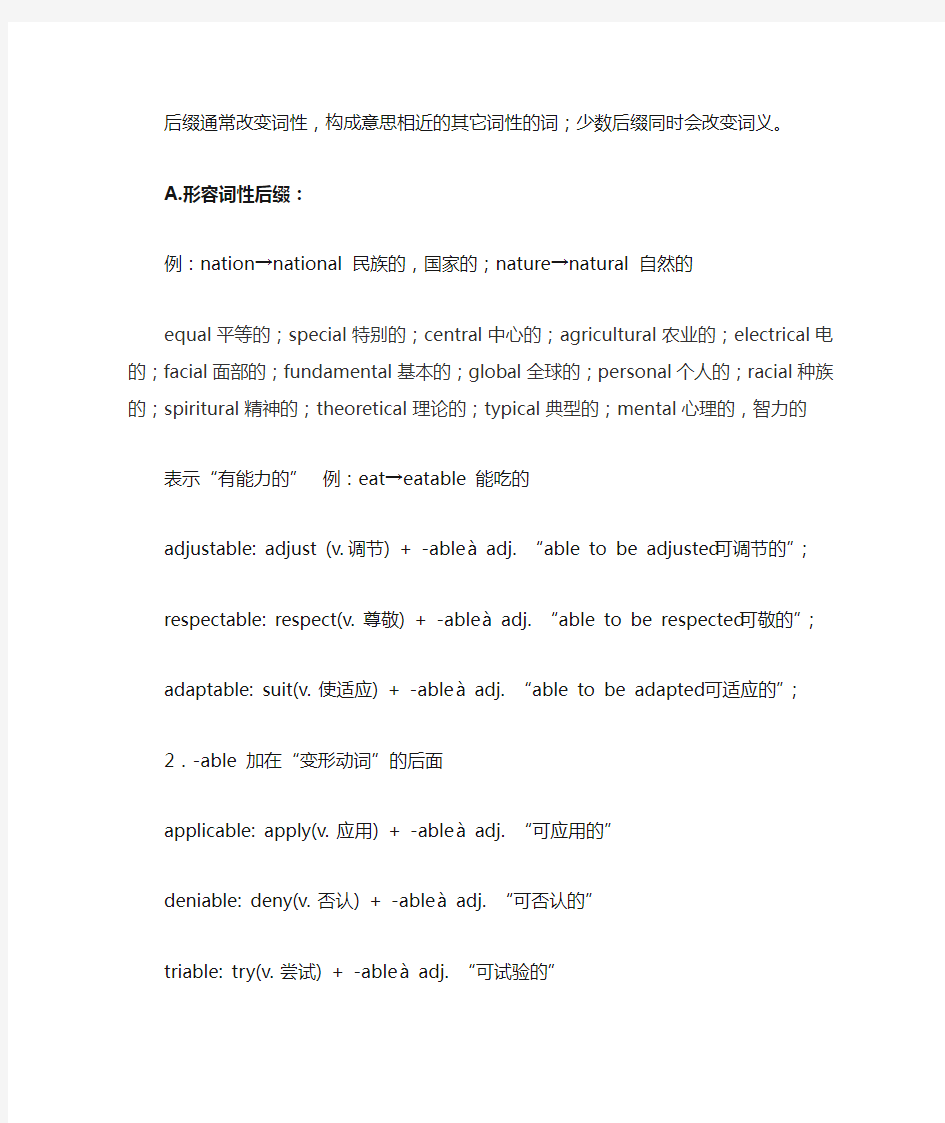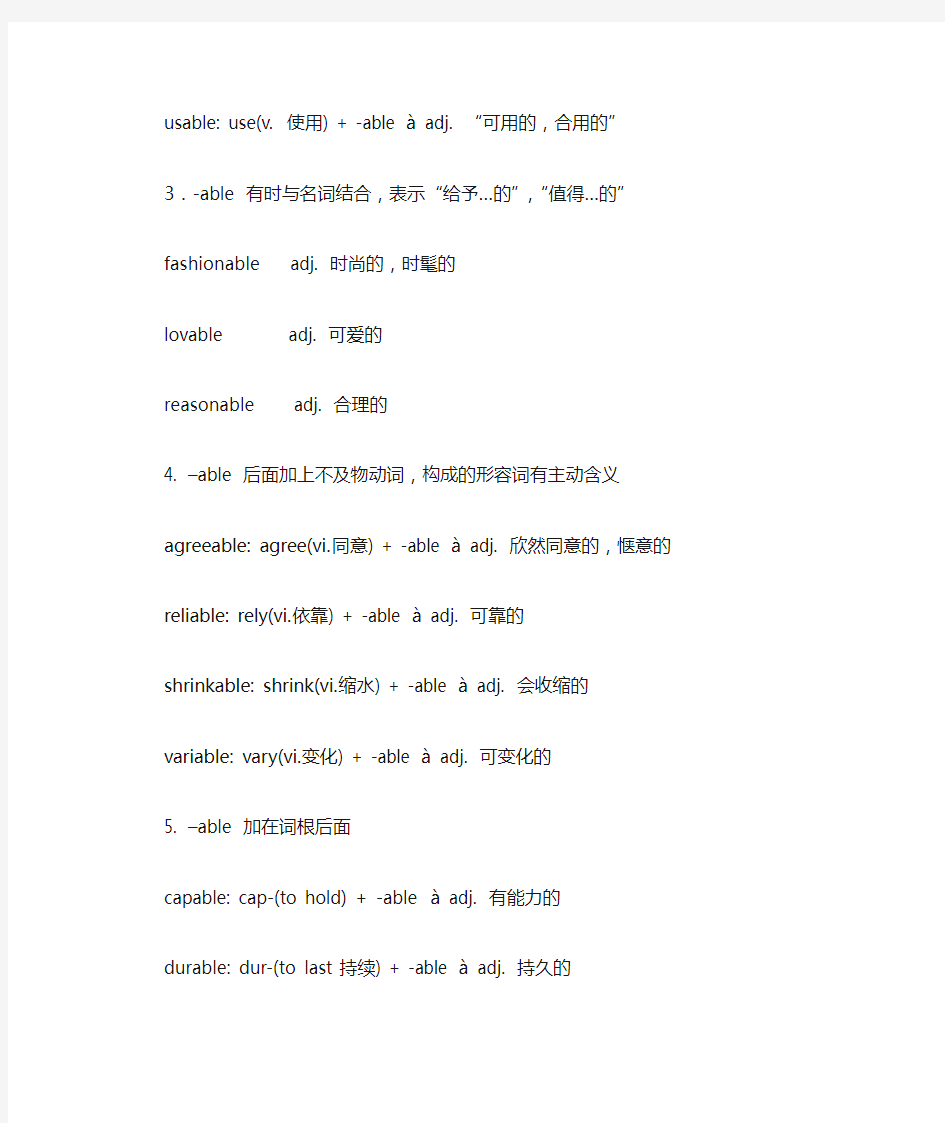形容词性后缀


后缀通常改变词性,构成意思相近的其它词性的词;少数后缀同时会改变词义。
A.形容词性后缀:
例:nation→national 民族的,国家的;nature→natural 自然的
equal平等的;special特别的;central中心的;agricultural农业的;electrical电的;facial面部的;fundamental 基本的;global全球的;personal个人的;racial种族的;spiritural精神的;theoretical理论的;typical典型的;mental心理的,智力的
表示“有能力的”例:eat→eatable 能吃的
adjustable: adjust (v. 调节) + -able àadj. “able to be adjusted可调节的”;
respectable: respect(v. 尊敬) + -able àadj. “able to be respected可敬的”;
adaptable: suit(v. 使适应) + -able àadj. “able to be adapted 可适应的”;
2.-able 加在“变形动词”的后面
applicable: apply(v. 应用) + -able àadj. “可应用的”
deniable: deny(v. 否认) + -able àadj. “可否认的”
triable: try(v. 尝试) + -able àadj. “可试验的”
usable: use(v. 使用) + -able àadj. “可用的,合用的”
3.-able 有时与名词结合,表示“给予…的”,“值得…的”
fashionable adj. 时尚的,时髦的
lovable adj. 可爱的
reasonable adj. 合理的
4. –able 后面加上不及物动词,构成的形容词有主动含义
agreeable: agree(vi.同意) + -able àadj. 欣然同意的,惬意的
reliable: rely(vi.依靠) + -able àadj. 可靠的
shrinkable: shrink(vi.缩水) + -able àadj. 会收缩的
variable: vary(vi.变化) + -able àadj. 可变化的
5. –able 加在词根后面
capable: cap-(to hold) + -able àadj. 有能力的
durable: dur-(to last持续) + -able àadj. 持久的
6. –ible 加上“动词词根”构成形容词
tangible: tang-(/tact- = to touch) + -ible àadj. that can be perceived by touch可触摸的visible: vis(= to see) + -ible àadj. that can be seen 可见的
terrible: terr(= to frighten) + -ible àadj. that can be frightened 可怕的
negligible: neglig(=neglect 忽略) + -ible àadj. that can be neglected 可忽略的
ian 表示“国家的,国家人的”。例:America→American 美国(人)的African(非洲人),American (美国人),Asian(亚洲人),Japanese(日本人),Chinese(中国人)
表示“方向的”。例:east→eastern东方的,south→southern南方的
northeastern a. 东北方的,在东北的,来自东北的northern a.北方的,北部的northwestern a. 在西北部的,西北方的,来自西北的southeastern a. 东南方的southern adj.南方的,南部的southwestern
例:beauty→beautiful 美丽的,care→careful 小心的
awful糟糕的可怕的wonderful好极的,精彩的careful小心的helpful有帮助的
useful有用的meaningful 有意义的beautiful漂亮的
表示否定例:care→careless粗心的,use→useless 无用的
Loveless 无爱的Endless 无尽的Colorless 暗淡的Prideless 无比骄傲的Hopeless 没有希望的Homeless 无家可归的Helpless 无助的Useless 没用的Thoughtless 不经思考的Guitless 无罪的Grapeless 无核的(葡萄嘿嘿~!)Faithless 没有信仰的Senceless 没有根据的restless 不安的shirtless 赤膊的Nameless 莫名的Voiceless 无声的
ical 例:electricity→electric/electrical 电的
electric电的,带电的electric current电流electrical与电有关的an electrical engineer电气工程师economic经济的an economic form经济形式economical经济的,节约的an economical stove经济炉,节能炉comic喜剧的,滑稽的a comic actor喜剧演员comical有趣的a comical hat有趣的帽子historic有历史意义的,历史上著名的a historic strike具有历史意义的大罢工historical历史上有过的,关于历史的 a historical novel历史小说politic策略性的,考虑周全的(言行、计划),精明的(人)a politic decision慎重的决定political政治上的,有关政治的 a political party政党
若名词是以-ic结尾,在变为形容词时,都是-ical后缀形式。例如:
skeptic n.怀疑者——skeptical adj.怀疑的heretic n.异教徒——heretical adj.异教的logic n.逻辑——logical adj.逻辑的hysteric n.歇斯底里——hysterical adj.歇斯底里的
但也有例外,如public既是名词,也是形容词;panic(n.恐慌),其形容词形式为panicky。
表示“人的”。例:China→Chinese 中国(人)的Japanese, Cantonese
单词后缀---ish,常有如下四层含义:
(1)加在形容词后,做形容词后缀,表示“稍带…….的”“有点…….的”
如:tall + ish =tallish 有点高的
Short + ish =shortish 有点矮的
young +ish =youngish 略微年轻的
例句She is tallish, brown-haired, and clear-skinned... 她身材偏高,棕色头发,皮肤光洁。
With her was a youngish man in a red jacket.
和她在一起的是一个略显年轻、身着红夹克衫的男人
(2)加在名词后,做形容词后缀,“像(某类人或事物)的”,“有…特征的”
如:woman +ish =womanish 有女人气质的,(形容男人有女人气)
man +ish =manish 有男人气质的,(形容女人有男人性格)
girl +ish =girlish 女孩气的
boy +ish =boyish 男孩气的
child +ish =childish 孩子气的
book +ish =bookish 好学的,书呆子气的
fool +ish =foolish 傻里傻气的monk (僧侣,修道士)+ish
=monkish 修道士似的devil (n.魔鬼vt.折磨) +ish =devilish 残忍的,邪恶的,魔鬼似的例句:She was always was a bookish child . 她一直是个爱读书的孩子。 a bookish way of thinking 书呆子气的想法
(3) 后缀(用于表示时间、日期、年龄的词之后)表示“…前后的”,“…左右的”
例句:I'll call you guys tomorrow. Noon-ish.. .我明天给你们打电话,中午前后吧。
The nurse was fiftyish. 这个护士50岁左右。
(4)加在某些“民族”名词后面,表示“…….人的,……民族的”
如:English 英国人的,英语的Jewish 犹太人的
Spanish 西班牙的British 英国的devilish
例:friend→friendly 友好的,year→yearly 每年的absently ad. 心不在焉地absolutely ad.完全地;绝对地absurdly ad. 荒诞地
表示“天气”等。例:cloud→cloudy 多云的,dust→dusty 多尘的cloudy
snowy windy sunny funny
例:famous 著名的,continuous 连续不断的表示"具有...的""实行...的""像...的"
continuous 连续的luxurious 奢华的cautious 谨慎的delecious 美味的precious珍贵的serious严重的,认真的glorious 光荣的humorous幽默的harmonious和谐的commodious宽敞的curious好奇的previous以前的例:childish 孩子气的,selfish 自私的例:golden 金色的,wooden 木制的,woolen 羊毛的
接在某些名词后构成形容词,有“由……制成的”、“含有……质的”“似……的”等含义。例如:wooden(木质的),wheaten(小麦制的),leaden(铅制的),earthen(泥质的,泥制的),woolen(羊毛制的),waxen(蜡制的,似蜡的),ashen(灰的,似灰的),golden(金质的,似金的),silken(丝的,如丝的),oaken(橡木制的)等等。
某些-en构成的形容词往往有比喻作用。如:brazenfaced(厚脸皮的),the Golden Age(黄金时代),wooden head(呆子),leaden silence(使人窒息的沉默),waxen complexion(蜡黄的面色)等。
例:active 积极的,collective 集体的
attractive active addictive conservative accusative emulative sensitive affirmative ablative, objective, accumulative
(完整word版)常见形容词词缀
常见形容词词缀 1.-able 以“-able”结尾的形容词一般有两种情况: (1)v.+able→adj. 以这种方式构成的形容词其意义为“能……的”、“可以(被)……的”、“适合于……的”、“值得……的”等,即有被动含义。例如:reliable(可以依靠的),drinkable (可以饮用的),eatable(可食用的)。 (2)n.+able→adj. 这种形容词意为“具有……特点的”,如valuable(有价值的),reasonable (有道理的),comfortable(舒适的)。 2.-ible 该词缀在意义上与“-able”相同,但主要用于拉丁语后。例如:terrible,horrible,invi sible,possible。 3.-al 该词缀大多是加在名词后形成形容词的。不过,有些“-al”后缀则仅体现了该词的形容词性,并非以这种方式构成形容词。“-al”意为“属于……的”、“有……特性的”。这类词在中学英语中颇多,如actual,general,international,medical,mental,moral,natural,official,several,special,usual。(这类形容词大部分没有比较级和最高级) 4.-an “-an”加在国名、地名之后,表明是相应的形容词,如American,African。 5.-ian “-ian”与“-an”相同。例如:Asian,Australian,Canadian,Indian,Italian。 6.-ant “-ant”表示“……性的”。带“-ant”后缀的形容词其相应名词往往是-ance或-ancy 后缀。例如:instant(instance),distant(distance),important(importance),brilliant(brilliancy),consta nt(constancy),pleasant。 7.-ent “-ent”与“-ant”非常相似。例如:absent(absence),different(difference),excelle nt(excellence),patient(patience),present(presence). 8.-ar “-ar”意为“……的”、“……性的”,如popular,particular,regular。 9.-ary “-ary”意为“……的”、“与……有关的”。例如:contrary,necessary,ordinary,prim ary,revolutionary。 10.-ed “-ed”加在动词之后形成形容词。实际上该形容词是由原动词的过去分词演变而来的,因此它有被动含义。这种形容词在中学英语中出现很多,有connected,discouraged,disappointed,engaged,exc ited,interested,limited,married,pleased,tired,united,used(习惯的),worried,wounded。 “-ed”也可加在动词之后形成复合形容词,如man-made,water-covered。 “-ed”还可加在名词之后形成复合形容词,如warm-hearted,warm-blooded,three-legged。11.-en “-en”有两种情况: (1)“-en”跟在一些物质名词之后构成形容词,表示“材料”或“质地”,如wooden,golden,earthe n。 (2)“-en”也可加在一些不规则动词之后形成形容词。这些形容词实际上是由过去分词转换而来的。例如:spoken,written,stricken,mistaken。 12.-ern “-ern”加在表示方位的名词之后,表示“……(方位)的”。这样的词有eastern,sout hern,western,northern等。 13.-ese “-ese”加在国名、地名之后构成相应形容词。例如:Chinese,Japanese. 14.-ful 这一后缀有两种情况: (1)加在名词之后构成形容词,表示“充满……的”、“有……性质的”,如beautiful,colourful,he lpful,powerful,successful,useful,wonderful。 (2)加在动词之后,所构成的形容词意为“易于……的”,如forgetful。 15.-ic “-ic”常常加在名词或依附于词干后,构成形容词,意为“……的”、“……似的”、
多个形容词修饰名词的顺序
多个形容词修饰名词的顺序 多个形容词修饰名词时,其顺序为: 限定词--数词--描绘词--(大小,长短,形状,新旧,颜色) --出处--材料性质,类别--名词 a small round table a tall gray building a dirty old brown shirt a famous German medical school an expensive Japanese sports car 典型例题: 1) Tony is going camping with ___ boys. A. little two other B. two little other C. two other little D. little other two 答案:C。由"限定词--数词--描绘词--(大小,长短,形状,新旧,颜色) --性质--名词"的公式可知数词,描绘词,性质依次顺序,只有C符合答案。 2) One day they crossed the ____bridge behind the palace. A. old Chinese stone B. Chinese old stone C. old stone Chinese D. Chinese stone old 答案A. 几个形容词修饰一个名词,他们的排列顺序是:年龄,形状,大小+颜色+来源+质地+用途+国家+名词。 3) ---- How was your recent visit to Qingdao ---- It was great. We visited some friends,and spent the ___days at the seaside. A. few last sunny B. last few sunny C. last sunny few D. few sunny last 答案:B。本题考查多个形容词的排序问题。一般与被修饰形容词关系密切的形容词靠近名词;如果几个形容词的重要性差不多,音节少的形容词在前,音节多的方在后,在不能确定时,可参照下表:
英语名词形容词动词后缀
名词后缀 (1)具有某种职业或动作的人 1)-an, -ain, 表示"……地方的人,精通……的人“American, historian, 2)-al, 表示"具有……职务的人" principal, 3)-ant,-ent, 表示"……者“merchant, agent, servant, student, 4)-ar, 表示"……的人“scholar, liar, peddler 5)-ard, -art, 表示"做……的人“coward, laggard, braggart(夸张者) 6)-arian, 表示"……派别的人,……主义的人“humanitarian, vegetarian 7)-ary, 表示"从事……的人" secretary, missionary 8)-ant, 表示"具有……职责的人" candidate, graduate 9)-ator, 表示"做……的人" educator, speculator(投机者) 10)-crat, 表示"某种政体,主义的支持者" democrat, bureaucrat 11)-ee, 表示"动作承受者" employee, examinee 12)-eer, 表示"从事于……人" engineer, volunteer 13)-er, 表示"从事某种职业的人, 某地区,地方的人" banker, observer, Londoner, villager 14)-ese, 表示" ……国人,………地方的人“Japanese, Cantonese 15)-ess, 表示"阴性人称名词,actress, hostess, manageress 16)-eur, 表示"……家“amateur, littérateur 17)-ian, 表示"……地方人,信仰…….教的人,从事……职业的人“Christian, physician(内科医生),musician 18)-ician, 表示"精通者,……家,“electrician, magician, technician 19)-icist, 表示"……家,…….者, …….能手“physicist, phoneticist, technicist 20)-ic, 表示"……者,……师" mechanic, critic 21)-ie, 表示"爱,指小" dearie, auntie, lassie(小姑娘) 22)-ier, 表示"从事……职业“cavalier, clothier, brazier(黄铜匠) 23)-ine, ian, 表示"阴性人称" heroine, ballerina 24)-ist, 表示"从事……研究者,信仰……主义者" pianist, communist, dentist, artist, chemist 25)-ive, 表示"动作者,行为者“native, captive 26)-logist, 表示"……学家,研究者" biologist, geologist(地质学家) 27)-or, 表示"……者" author, doctor, operator, 28)-ster, 表示"做…….事情的人“youngster, gamester(赌徒),songster 29)-yer, 表示" 从事……职业者“lawyer (2). 构成,具有抽象名词的含义本文 1)-acy, 表示"性质,状态,境遇" accuracy, diplomacy 2)-age, 表示"状态,行为,身份及其结果,总称" courage, storage, marriage 3)-al, a)表示"事物的动作,过程“refusal, arrival, survival, denial, approval b)表示具体的事物manual, signal, editorial, journal 4)-ance, -ence表示"性质,状况,行为,过程,总量,程度“endurance, importance, diligence, difference, obedience 5)-ancy, -ency, 表示"性质,状态,行为,过程" frequency, urgency, efficiency, 6)-bility, 表示"动作,性质,状态" possibility, feasibility, 7)-craft, 表示"工艺,技巧“woodcraft, handicraft, statecraft(治国策) 8)-cracy, 表示"统治,支配" bureaucracy, democracy 9)-cy, 表示"性质,状态,职位,级别" bankruptcy(破产),supremacy 10)-dom, 表示"等级,领域,状态" freedom, kingdom, wisdom 11)-ery, -ry, 表示"行为,状态,习性" bravery, bribery, rivalry 12)-ety, 表示"性质,状态“variety, dubiety(怀疑) 13)-faction, -facture, 表示"作成,……化,作用" satisfaction, manufacture 14)-hood, 表示"资格,身份, 年纪,状态" childhood, manhood, falsehood 15)-ice, 表示"行为,性质,状态" notice, justice, service 16)-ine, 表示"带有抽象概念" medicine, discipline, famine 17)-ing, 表示"动作的过程,结果" building, writing, learning 18)-ion, -sion, -tion, -ation, -ition, 表示"行为的过程,结果,状况" action, solution, conclusion, destruction, expression, 19)-ise, 表示"性质,状态“exercise, merchandise(商业) 20)-ism, 表示"制度,主义,学说,信仰,行为" socialism, criticism, colloquialism, heroism 21)-ity, 表示"性质,状态,程度“purity, reality, ability, calamity 22)-ment, 表示"行为,状态,过程,手段及其结果treatment, movement, judgment, punishment, argument 23)-mony, 表示"动作的结果,状态" ceremony, testimony 24)-ness, 表示"性质,状态,程度" goodness, kindness, tiredness, friendliness
多个形容词修饰名词的顺序归纳
多个形容词修饰名词时,其顺序为: 限定词--数词--描绘词--(大小,长短,形状,新旧,颜色) --出处--材料性质,类别--名词 a small round table a tall gray building a dirty old brown shirt a famous German medical school an expensive Japanese sports car 典型例题: 1) Tony is going camping with ___ boys. A.little two other B. two little other C.two other little D.little other two 答案:C。由"限定词--数词--描绘词--(大小,长短,形状,新旧,颜色) --性质--名词"的公式可知数词,描绘词,性质依次顺序,只有C符合答案。 2)One day they crossed the ____bridge behind the palace. A. old Chinese stone B. Chinese old stone C. old stone Chinese D. Chinese stone old 答案A. 几个形容词修饰一个名词,他们的排列顺序是:年龄,形状,大小+颜色+来源+质地+用途+国家+名词。 3) ---- How was your recent visit to Qingdao? ---- It was great. We visited some friends,and spent the ___days at the seaside. A. few last sunny B. last few sunny C. last sunny few D. few sunny last 答案:B。本题考查多个形容词的排序问题。一般与被修饰形容词关系密切的形容词靠近名词;如果几个形容词的重要性差不多,音节少的形容词在前,音节多的方在后,在不能确定时,可参照下表: 限定词+数量词(序数词在前,基数词在后)+性状形容词+大小、长短、高低等形体+
形容词后缀大全
(1)带有“属性,倾向,相关”的含义 1)-able, -ible, movable, comfortable, applicable, visible, responsible 2)-al, natural, additional, educational 3)-an, ane, urban, suburban, republican 4)-ant, -ent, distant, important, excellent 5)-ar, similar, popular, regular 6)-ary, military, voluntary 7)-ice, -atie, ical, politic, systematic, historic, physical, 8)-ine, masculine, feminine, marine 9)-ing, moving, touching, daring 10)-ish, foolish, bookish, selfish 11)-ive, active, impressive, decisive 12)-ory, satisfactory, compulsory 13)-il, -ile, -eel, fragile, genteel(文雅的) (2) 表示“相象,类似”的含义 1)-ish, boyish, childish 2)-esque, picturesque 3)-like, manlike, childlike 4)-ly, manly, fatherly, scholarly, motherly 5)-some, troublesome, handsome 6)-y, milky, pasty (3) 表示“充分的”含义 1)-ful, beautiful, wonderful, helpful, truthful 2)-ous, dangerous, generous, courageous, various 3)-ent, violent
形容词可以修饰什么词
英语中形容词修饰名词或是相当于名词的词,比如说动名词、名词性词组等。 什么是形容词 形容词是词类的一种,主要用来描写或修饰名词或代词,表示人或事物的性质、状态、特征或属性,常用作定语,也可作表语、补语或状语。例如: 1、good好的; 2、clever,聪明的; 3、beautiful美丽的; 4、lovely可爱的; 5、delicious 美味的; 6、nice美好的; 7、honest诚实的 8、trustful信任的; 9、brave勇敢的;10、generous 慷慨的; 11、enthusiastic热心的;12、radient光芒四射的,喜悦的;13、rapture全神贯注的,欢天喜地的;14、reasonable合情合理的;15、responsible负责的; 16、romantic浪漫的;17、hearty衷心的亲切的;18、helpful有益的;19、honesty 诚实的;20、honey甜蜜的; 21、humor幽默的22、useful有用的23、Brilliant英明的24、United和睦的25、beautiful 美丽的; 26、smart灵巧的;27、obedient服从的;28、objective客观的;29、obliging乐于助人的,礼貌的;30、diligent勤奋的; 多个形容词修饰名词的顺序 多个形容词修饰名词时,其顺序为:限定词--数词--描绘词--(大小,长短,形状,新旧,颜色)--出处--材料性质,类别--名词 a small round table a tall gray building a dirty old brown shirt a famous German medical school an expensive Japanese sports car 典型例题: 1)Tony is going camping with ___ boys.
26种英语形容词后缀讲解
26种英语形容词后缀讲解 ◆-able 以“-able”结尾的形容词一般有两种情况: (1)v.+able→adj. 以这种方式构成的形容词其意义为“能……的”、“可以(被)……的”、“适合于……的”、“值得……的”等,即有被动含义。例如:reliable(可以依靠的),drinkable (可以饮用的),eatable(可食用的)。 (2)n.+able→adj. 这种形容词意为“具有……特点的”,如valuable(有价值的),reasonable(有道理的),comfortable (舒适的)。 ◆-ible 该词缀在意义上与“-able”相同,但主要用于拉丁语 后。例如:terrible,horrible,invi sible,possible。 ◆-al 该词缀大多是加在名词后形成形容词的。不过,有些“-al”后缀则仅体现了该词的形容词性,并非以这种方式构成形容词。“-al”意为“属于……的”、“有……特性的”。这类词在中学 英语中颇多,如 actual,general,international,medical,mental,moral,natural, official,several,special,usual。(这类形容词大部分没有比较 级和最高级) ◆-an “-an”加在国名、地名之后,表明是相应的形容词,如 American,African。 ◆-ian “-ian”与“-an”相同。例如: Asian,Australian,Canadian,Indian,Italian。
◆-ant “-ant”表示“……性的”。带“-ant”后缀的形容词其相 应名词往往是-ance或-ancy后缀。例如:instant(instance),distant(distance),important(importance), brilliant(brilliancy),consta nt(constancy),pleasant。 ◆-ent “-ent”与“-ant”非常相似。例如: absent(absence),different(difference),excelle nt(excellence),patient(patience),present(presence). ◆-ar “-ar”意为“……的”、“……性的”,如 popular,particular,regular。 ◆-ary “-ary”意为“……的”、“与……有关的”。例如: contrary,necessary,ordinary,prim ary,revolutionary。 ◆-ed “-ed”加在动词之后形成形容词。实际上该形容词是由原动词的过去分词演变而来的,因此它有被动含义。这种形容 词在中学英语中出现很多,有 connected,discouraged,disappointed,engaged,exc ited,interested,limited,married,pleased,tired,united,used (习惯的),worried,wounded。 “-ed”也可加在动词之后形成复合形容词,如 man-made,water-covered。 “-ed”还可加在名词之后形成复合形容词,如 warm-hearted,warm-blooded,three-legged。 ◆-en “-en”有两种情况:
专题12 后缀词的主要构成方式(3)形容词(原卷版)
2020年高考英语词汇解题妙招 专题12后缀词的主要构成方式(3)形容词(原卷版)由词根(或单词) 附加前缀、后缀构成新词的方法叫派生法。由派生法构成的词叫派生词. 大体上讲,派生法有两种:加前缀、加后缀。本讲对后缀(suffix)进行概述。专讲后缀构成的形容词. 我们大家给非常熟悉的“老朋友”加上新的后缀, 就构成了很多“新朋友”了, 让我们先从整体上重新认识他们吧。详细内容如下: 根据下划线词在句中所作句子成分, 判断其词性及其意义。 1. How does the woman fee l about James’ situation? A. Embarrassed. B. Concerned. C. Disappointed.(2019年普通高等学校招生全国统一考试(全国卷I)) 【答案】adj. 有关的;关心的 【解析】原本concern是vt. 影响,牵扯(某人);关系到,涉及;使担心; n. 担心,忧虑;关爱,关心;关心的事,负责的事;关系;公司,企业;(非正式)复杂的物体 后缀--ed的用法: 加了ed以后是过去分词,可以做定语,所以成了形容词。比如,interested, excited等等。 2. But he’s nervous."I’m here to tell you today why you should … should…"Chris trips on the"-ld,"a pronunciation difficulty for many non-native English speakers.(2019年普通高等学校招生全国统一考试(全国卷I)) 【答案】adj. 神经的;紧张不安的;强健有力的 比较级more nervous最高级most nervous 【解析】原本nerve是n. 神经;勇气;[植] 叶脉; 复数nerves; vt. 鼓起勇气; 过去式nerved过去分词nerved 现在分词nerving第三人称单数nerves.在此其后加ous构成一个形容词。---ous形容词标志,通常放在一个完整的单词后,表示“…的” 例如: dangerous 危险的; mountainous 多山的;巨大的;山一般的; poisonous 有毒的;有害的;恶意的;<口>讨厌的; 3. Learning English as a second language can be a painful experience.(2019年普通高等学校招生全国统一考试(全国卷I)) 【答案】adj. 痛苦的;疼痛的;令人不快的;比较级more painful最高级most painful
形容词性后缀
后缀通常改变词性,构成意思相近的其它词性的词;少数后缀同时会改变词义。 A.形容词性后缀: 例:nation→national 民族的,国家的;nature→natural 自然的 equal平等的;special特别的;central中心的;agricultural农业的;electrical电的;facial面部的;fundamental 基本的;global全球的;personal个人的;racial种族的;spiritural精神的;theoretical理论的;typical典型的;mental心理的,智力的 表示“有能力的”例:eat→eatable 能吃的 adjustable: adjust (v. 调节) + -able àadj. “able to be adjusted可调节的”; respectable: respect(v. 尊敬) + -able àadj. “able to be respected可敬的”; adaptable: suit(v. 使适应) + -able àadj. “able to be adapted 可适应的”; 2.-able 加在“变形动词”的后面 applicable: apply(v. 应用) + -able àadj. “可应用的” deniable: deny(v. 否认) + -able àadj. “可否认的” triable: try(v. 尝试) + -able àadj. “可试验的” usable: use(v. 使用) + -able àadj. “可用的,合用的” 3.-able 有时与名词结合,表示“给予…的”,“值得…的” fashionable adj. 时尚的,时髦的 lovable adj. 可爱的 reasonable adj. 合理的 4. –able 后面加上不及物动词,构成的形容词有主动含义 agreeable: agree(vi.同意) + -able àadj. 欣然同意的,惬意的 reliable: rely(vi.依靠) + -able àadj. 可靠的 shrinkable: shrink(vi.缩水) + -able àadj. 会收缩的 variable: vary(vi.变化) + -able àadj. 可变化的 5. –able 加在词根后面 capable: cap-(to hold) + -able àadj. 有能力的 durable: dur-(to last持续) + -able àadj. 持久的 6. –ible 加上“动词词根”构成形容词 tangible: tang-(/tact- = to touch) + -ible àadj. that can be perceived by touch可触摸的visible: vis(= to see) + -ible àadj. that can be seen 可见的 terrible: terr(= to frighten) + -ible àadj. that can be frightened 可怕的 negligible: neglig(=neglect 忽略) + -ible àadj. that can be neglected 可忽略的 ian 表示“国家的,国家人的”。例:America→American 美国(人)的African(非洲人),American (美国人),Asian(亚洲人),Japanese(日本人),Chinese(中国人) 表示“方向的”。例:east→eastern东方的,south→southern南方的 northeastern a. 东北方的,在东北的,来自东北的northern a.北方的,北部的northwestern a. 在西北部的,西北方的,来自西北的southeastern a. 东南方的southern adj.南方的,南部的southwestern 例:beauty→beautiful 美丽的,care→careful 小心的 awful糟糕的可怕的wonderful好极的,精彩的careful小心的helpful有帮助的 useful有用的meaningful 有意义的beautiful漂亮的
当两个以上形容词修饰一个名词
描大形新颜国材 当两个以上形容词修饰一个名词,形容词该如何排列?为什么不能说a black new pen,而是说成a new black pen?这里面有无规则可循?如果你记住Opshacom这个为帮助记忆而杜撰的词,就能掌握英语中形容词排列的顺序。 Opshacom中p代表opinion,指表示人们观点的形容词,如beautiful,horrible,lovely,nice等; sh代表shape,指表示形状的形容词,如long,short,round, narrow 等; a代表age,指表示年龄、时代的形容词,如old,new,young 等; c代表colour,指表示颜色的形容词,如red,black, orange 等; o代表origin,指表示国籍、地区的形容词,如British,Canadian,German等; m代表material,指表示材料的形容词,如plastic,metal,aluminium等。 英语中这六类形容词连用时就按上述先后顺序排列,如a nice long new black British plastic pen 当然,实际语言使用中不可能出现这么多形容词连用的情况。 请根据形容词排列规则完成以下练习: 1.She has a ___ jacket.(leather,brown,beautiful) 2.He has a ___ car. (American,long,red) 3.They live in a ___ house. (old,beautiful) 4.We have a ___ table. (antique,small,wooden) 5.He has a ___ jumper. (woollen, lovely, red) 6.She has a ___ ring. (diamond,new,fabulous) 7.It was a ___ song.(French,old, lovely) 8.He owns a ___ dog.(black,horrible,big)
名词变形容词的十大规律
r s o 名词变形容词的十大规律 英语中,有时在名词之前或末尾加上不同的前缀或后缀就可以变为形容词。 如: sleep (睡觉) →asleep (睡着的) →sleepy (瞌睡的) help (帮助)→helpful (有帮助的) 下面将名词变为形容词的构成方法归纳如下: 一、 名词加“-y”构成形容词。如: rain (雨水) →rainy (多雨的) wind (风) →windy (多风的,风大的) cloud (云) →cloudy (多云的,阴天的) snow (雪)→ snowy (多雪的) sun (太阳)→ sunny (多阳光的,明朗的) [特别提醒:别忘了双写n] 以一个辅音字母结尾的重读闭音节结尾,须双写最后一个辅音字母。 luck (运气)→ lucky (幸运的) noise (嘈杂声) →noisy (嘈杂的,喧闹的) [特别提醒:别忘了去掉e]
以不发音的“e”结尾,须去掉“e”。 health (健康)→healthy(健康的) 二、名词加"-ful"构成形容词,表示肯定。如: use (使用)→useful(有用的) help (帮助)→helpful(有帮助的) harm (伤害,损害)→harmful(有害的) forget (忘记)→forgetful(健忘的) beauty (美丽)→beautiful(美丽的) [特别提醒:别忘了把-y变成-i,再加-ful] 辅音字母加“y”结尾,先改“y”为“i”。 care (关心,小心)→careful(小心的,仔细的)pain (疼痛)→painful(疼痛的) wonder (惊奇,想知道)→wonderful(极好的)color (颜色)→colorful(彩色的;色彩艳丽的)thank (感谢)→thankful(感激的,欣赏的)
常用英语形容词后缀
形容词后缀(1)带有"属性,倾向,相关"的含义 1) -able, -ible, movable, comfortable, applicable, visible, responsible 可移动的舒服的适当可应用明显可得到责任心 2) -al, natural, additional, educational, physical, 自然天生额外附加教育身体自然界 3) -an, ane, urban, suburban, republican 都市城郊土气共和国政体 4) -ant, -ent, distant, important, excellent 遥远冷漠不清晰重要卓越 5) -ar, similar, popular, regular 相似受欢迎规律 6) -ary, military, voluntary 军事好战自愿有意 7) -ice, -atie, ical, politic, systematic, historic, 谨慎有见识系统一贯历史 8) -ine, masculine, feminine, marine 有男子气概女孩子气海产海军 9) -ing, moving, touching, daring 感动可移动同情感人胆大意气风发勇敢 10) -ish, foolish, bookish, selfish, boyish, childish 愚蠢好学书呆子自私男孩子气孩子气 11) -ive, active, impressive, decisive 积极好动印象深刻决断坚决 12) -ory, satisfactory, compulsory 令人满意强制性;义务的必修 13) -il, -ile, -eel, fragile, genteel 表示"相象,类似"的含义 易碎脆弱文雅的;有礼貌的;有教养的;上流社会 2) -esque, picturesque 3) -like, manlike, childlike 4) -ly, manly, fatherly, scholarly, motherly 5) -some, troublesome, handsome 6) -y, milky, pasty 表示"充分的"含义 1) -ful, beautiful, wonderful, helpful, truthful 2) -ous, dangerous, generous, courageous, various 3) -ent, violent, 表示由某种物质形成,制成或生产的含义 1) -en, wooden, golden, woolen
多个形容词修饰一个名词的先后位置的口诀
多个形容词修饰一个名词的先后位置的口诀 好美小高状其新,颜色国料特别亲。 国料是国家和材料,也就是说先放表形状大小的形容词,把颜色、国家、材料的形容词接着所修饰的名词,如:a big brown cow, a little, red school, a little Chinese girl等。 所以在英语学习中只要善于去归纳总结,就可以发现许多窍门。把一些难以记忆的知识,编成口诀去记忆,就可减少枯燥,提高学习的兴趣和效率。 美小圆旧黄,法国木书房 多个形容词修饰一个名词- - 当两个以上形容词修饰一个名词,形容词该如何排序?我们为什么不能说a black new pe n, 而是说a new black pen?这里面有无规则可循?如果你记住Opshacom这个帮助记忆而杜撰的词,就能掌握英语中形容词排列的顺序。 Opshacom中op代表opinion,指表示人们观点的形容词,如beautiful,horrible,lovely,ni ce等 sh代表shape,指long,short,round,narrow等; a代表age,指表示年龄、时代的形容词,如old,new,young等; c代表colour,指表示颜色的形容词,如red,black,orange等; o代表origin,指表示国籍、地区的形容词,如British,Canadian,German等; m代表material,指表示材料的形容词,如plastic,metal,aluminium等。 英语中这六类形容词连用时就按上述顺序排列,如: a nice long new black British plastic pen. 简单的说:好美小高状其新,颜色国料特别亲 ①冠词、指示代词(this,those等)→②所有格(my,Tom's等)→③序数词(first等)→④基数词(two等)→⑤特征、特性(常含主观看法;good等)→⑥大小、长短、高低→⑦年龄、温度、新旧→⑧形态、形状→⑨颜色→⑩国籍、地区、出处、来源→⑾物质、材料→⑿用途、类别、目的→被修饰的名词 在英语中,当名词有多个形容词修饰时,就有它们的先后顺序。下面的口诀可帮你记住这一先后顺序,也是解题的关键。 限定描绘大长高, 形状年龄和新老; 颜色国籍跟材料, 作用类别往后靠; 其中,“限定词”包括:冠词、物主代词、指示代词、或数词,它位于各类形容词前。它本身分为三位,即:前、中、后。前位限定词有all、half、both、分数和倍数;中位限定词有冠词、指示代词、物主代词等;后位限定词有基数词和序数词,但序数词位于基数词前。如: both my hands、all half his income等。“描绘”性形容词如:beautiful、bad、cold、great等。“大长高”表示大小、长短、高低等一些词。表示“形状”的词如:round square等。“国籍”指一个
形容词后缀大全以及词例
形容词后缀大全以及词例 表示“可…的,能…” 【例】 knowable ['n?u?bl] adj. 可知的 inflammable [?n'fl?m?b(?)l] adj. 易燃的(inflame点燃)conceivable [k?n'si?v?b(?)l] adj. 想象得出的(conceive 设想,想象) 表示“具有…特征的” 【例】 herbaceous [h??'be???s] adj. 草本植物的(herb草)curvaceous [k??'ve???s] adj. 有曲线美的(curve曲线)foliaceous [,f??l?'e???s] adj. 叶状的(foli 叶+aceous;参考:foliage树叶) 表示“有特征的,多…的” 【例】 sagacious [s?'ge???s] adj. 睿智的(sage智者)
capacious [k?'pe???s] adj. 宽敞的(cap能→的+acious;参考:capble有能力的) fallacious [f?'le???s] adj. 错误的(fall错;参考:fallacy谬误) 表示“…的” 【例】 personal ['p??s(?)n(?)l] adj. 个人的(person人)continertal [k?nt?'nent(?)l] adj. 大陆的(contonent大陆) exceptional [?k'sep?(?)n(?)l] adj. 例外的(exception 例外) 可表名词和形容词,“…地方,.…人 【例】 American [?mer?k?n] adj. 美洲的 n. 美洲人republican [r?'p?bl?k(?)n] adj. 共和国的 n.共和党人 suburban [s?'b??b(?)n] adj. 郊区的
英语形容词修饰的顺序
一, 大小,长短,形状+年龄、新旧+国籍、出处+材料+用途、类别 二,比较实用,又好记 大哥限描大,二哥形龄颜,小弟籍物类,同站名词前。 限:限定词,the my a this等 描:描绘性形容词,brave beautiful,lovely,nice等 大;大小,高低,长短等形容词。Big,large,small等 形:形状,round,square等 龄;年龄大小、新旧、年代等。Young,old、new等 颜;颜色。Red、blue、green等 籍:国籍、地区、出处,chinese、american、japanese等 物:物质材料的形容词,golden,wooden,wax等 类:表示类别,用途。Medical,chemical,writing等 一个旧的很漂亮的黑色的日本式方形木制小写字桌 A pretty little square old black Japanese wooden writing desk。 一件漂亮的中式新的短装羊毛外套 A beautiful short new red Chinese woolen coat 三.巧记形容词排列顺序 This girl Linda’cousin A,pretty little Spanish B,Spanish little pretty C,spanish pretty D,little pretty Spanish 此题选A。该题是对形容词排列顺序的考察,在英语中,当名词有多个形容词修饰时,就有他们的先后顺序。下面的口诀可帮你记住这已先后顺序,也是解题的关键。 限定描绘大长高,形状年龄和新老,颜色国籍跟材料,作用类别往后排。 其中,限定词包括,冠词、物主代词、指示代词、或数词,它位于各类形容词前。它本身分为三位,即:前、中、后。前位限定词有all、half、both分数和倍数,中位限定词有冠词、指示代词、物主代词等;后位限定词有基数词和序数词,但序数词位于基数词前,如:both my hands 、all half his income 等。“描绘|”性形容词如,beautiful、bad、cold、great等。大长高表示大小、长短、高低等一些词。表示形状的词如:round、square等。国籍指一个国家或地区的词。材料的词如:wooden、woollen、stone、silk等。作用类别的词如:medical、college、writing desk、police car等 四、县官行令杀国材 县、表示限定词,官,指的是冠词,行就是指性质的定语,令,表示年龄,杀表示颜色,国,表示国籍,材表示材料 五、熟记规则:大小形状和新老,颜色国际出材料 多个形容词修饰同一名词时的顺序是固定的,其顺序是,a、冠词、指示代词、不定代词、物主代词b、序数词、基数词c、一般性描绘形容词d、大小、长短、形状、年龄、新旧e、颜色、f、国籍、出处g、材料h、用途、类别+最终被修饰的名词或动名词例:a beautiful little red flower 一朵美丽的小花。Those four old-looking grey wooden houses 我有一个中国制造木质红色的大圆桌子:I have a big round red wooden Chinese table 六、专业记忆 Opshacom
